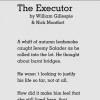"The Executor" (2005) is the collaborative work of authors William Gillespie and Nick Montfort. William Gillespie is the founder of Spineless Books, an independent book publisher based out of Urbana, Illinois, and has exhibited work on creative writing and independent publishing. Nick Montfort is an associate professor of digital media at the Massachusetts Institute of Technology (MIT) and is currently the president of the Electronic Literature Organization
"The Executor" was written in an unusual way. Each author took turns writing sentences, beginning with the final sentence of the story and working backwards. Montfort and Gillespie have a history of unusual collaboration, their work 2002: A Palindrome Story, a two thousand and two word palindrome, is recognized by Oulipa as the world's longest literary palindrome.
In a release from Spineless Books, Montfort and Gillespie state that "without planning the content of the story, [they] alternated writing sentences" (Montfort). Each author contributed sentences without knowing the direction that the narrative would take.
The plot follows Jeremy Salader, who returns to a past he has left behind. At some point in his life he made the decision to escape from his life and move towards a new future. A phone call forces Salader to return to his home. By simply looking through the phonebook, Jeremy realizes that his sister, Selma, is still living in the family home caring for their dying mother. When Jeremy meets with Selma, Jeremy's attachment to his estranged mother becomes clear. Selma feels that Jeremy and his mother need to reconcile because she can no longer deal with a dying parent alone. No decision is made and both siblings are left contemplating the future.
"The Executor," built on both processing, an open source programming language and environment for the creation of images, animation and interactions, as well as Java. The story is presented as a scrolling text with the speed of the scrolling gradually increasing as the story progresses. The screen gradually darkens, from white to black, and the text pulses as the story unfolds. The pulsing, and breathing of the text describes the collaborative nature of the work. It mirrors the back and forth process of writing the authors used to write the story. The visual elements also convey Jeremy's growing anxiety about seeing his mother and the mother's progression towards death. The reversible chronology of "The Executor" formally suggests that the past is not distinct from the future: the two intertwine and act upon each other in social, psychological, and narrative systems alike.
Works Cited
Montfort, Nick, and William Gillespie. "The Executor." Spinelessbooks.com. Spineless Books, n.d. Web. 22 March 2011.
Jonathan Jarvie was a student of Dr. Kiki Benzon for a course in Contemporary Fiction taught at the University of Lethbridge, Canada during the Winter term of 2011.
